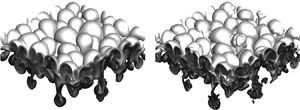Crossref Citations
This article has been cited by the following publications. This list is generated based on data provided by
Crossref.
Peng, Naifu
Yang, Yue
and
Xiao, Zuoli
2021.
Effects of the secondary baroclinic vorticity on the energy cascade in the Richtmyer–Meshkov instability.
Journal of Fluid Mechanics,
Vol. 925,
Issue. ,
Zhou, Ye
Williams, Robin J.R.
Ramaprabhu, Praveen
Groom, Michael
Thornber, Ben
Hillier, Andrew
Mostert, Wouter
Rollin, Bertrand
Balachandar, S.
Powell, Phillip D.
Mahalov, Alex
and
Attal, N.
2021.
Rayleigh–Taylor and Richtmyer–Meshkov instabilities: A journey through scales.
Physica D: Nonlinear Phenomena,
Vol. 423,
Issue. ,
p.
132838.
Liu, Y.
and
Guan, Y. K.
2021.
Large eddy simulation of the turbulent mixing at an oblique interface induced by non-classical planar shock waves.
AIP Advances,
Vol. 11,
Issue. 4,
Schilling, Oleg
2021.
Self-similar Reynolds-averaged mechanical–scalar turbulence models for Rayleigh–Taylor, Richtmyer–Meshkov, and Kelvin–Helmholtz instability-induced mixing in the small Atwood number limit.
Physics of Fluids,
Vol. 33,
Issue. 8,
Li, Xinliang
Fu, Yaowei
Yu, Changping
and
Li, Li
2021.
Statistical characteristics of turbulent mixing in spherical and cylindrical converging Richtmyer–Meshkov instabilities.
Journal of Fluid Mechanics,
Vol. 928,
Issue. ,
Huang, Shenghong
Zhang, Jiawei
Ding, Juchun
and
Luo, Xisheng
2022.
Richtmyer--Meshkov instability with ionization at extreme impact conditions.
Physics of Fluids,
Vol. 34,
Issue. 7,
Liu, Hong
Yu, Bin
Zhang, Bin
and
Xiang, Yang
2022.
On mixing enhancement by secondary baroclinic vorticity in a shock–bubble interaction.
Journal of Fluid Mechanics,
Vol. 931,
Issue. ,
Yan, Zheng
Fu, Yaowei
Wang, Lifeng
Yu, Changping
and
Li, Xinliang
2022.
Effect of chemical reaction on mixing transition and turbulent statistics of cylindrical Richtmyer–Meshkov instability.
Journal of Fluid Mechanics,
Vol. 941,
Issue. ,
Zhang, Duo
Ding, Juchun
Si, Ting
and
Luo, Xisheng
2023.
Divergent Richtmyer–Meshkov instability on a heavy gas layer.
Journal of Fluid Mechanics,
Vol. 959,
Issue. ,
Zhang, Duo
Ding, Juchun
Li, Ming
Zou, Liyong
and
Luo, Xisheng
2023.
Effects of reverberating waves and interface coupling on a divergent Richtmyer–Meshkov instability.
Journal of Fluid Mechanics,
Vol. 975,
Issue. ,
Groom, Michael
and
Thornber, Ben
2023.
Numerical simulation of an idealised Richtmyer–Meshkov instability shock tube experiment.
Journal of Fluid Mechanics,
Vol. 964,
Issue. ,
Zhou, Zhangbo
Ding, Juchun
Cheng, Wan
and
Luo, Xisheng
2023.
Scaling law of structure function of Richtmyer–Meshkov turbulence.
Journal of Fluid Mechanics,
Vol. 972,
Issue. ,
Li, Linfei
Jin, Tai
Zou, Liyong
Luo, Kun
and
Fan, Jianren
2023.
Numerical study of Richtmyer–Meshkov instability of a flat interface driven by perturbed and reflected shock waves.
Physics of Fluids,
Vol. 35,
Issue. 2,
El Rafei, Moutassem
and
Thornber, Ben
2024.
Turbulence statistics and transport in compressible mixing driven by spherical implosions with narrowband and broadband initial perturbations.
Physical Review Fluids,
Vol. 9,
Issue. 3,
Zhou, Zhangbo
Ding, Juchun
and
Cheng, Wan
2024.
Mixing and inter-scale energy transfer in Richtmyer–Meshkov turbulence.
Journal of Fluid Mechanics,
Vol. 984,
Issue. ,
Qi, Han
He, Zhi-wei
Xu, Ai-guo
and
Zhang, You-sheng
2024.
The vortex structure and enstrophy of the mixing transition induced by Rayleigh–Taylor instability.
Physics of Fluids,
Vol. 36,
Issue. 11,
Singh, Satyvir
and
Jalleli, Dhouha Taib
2024.
Investigation of coupling effect on the evolution of Richtmyer-Meshkov instability at double heavy square bubbles.
Science China Physics, Mechanics & Astronomy,
Vol. 67,
Issue. 1,
Qi, Han
He, Zhiwei
Xu, Aiguo
and
Zhang, Yousheng
2025.
Quantifying the temporal-spatial transition of rayleigh-taylor mixing.
Physica D: Nonlinear Phenomena,
Vol. 483,
Issue. ,
p.
134975.
Yan, Zheng
Chen, Zhu
Li, Zhiyuan
Wu, Junfeng
Fan, Zhengfeng
Yu, Changping
Li, Xinliang
and
Wang, Lifeng
2025.
The role of double‐layer vortex rings with the local swirl in the rapid transition to turbulent flows in Richtmyer–Meshkov instability with reshock.
Journal of Fluid Mechanics,
Vol. 1003,
Issue. ,
Zhao, Yong
Ding, Juchun
He, Dong
Zhou, Zhangbo
and
Luo, Xisheng
2025.
Convergent Richtmyer–Meshkov turbulence by time-resolved planar laser-induced fluorescence measurement.
Journal of Fluid Mechanics,
Vol. 1007,
Issue. ,

 $\theta$ of the integral width and mixed mass is shown to marginally depend on the initial Reynolds number
$\theta$ of the integral width and mixed mass is shown to marginally depend on the initial Reynolds number  $Re_0$, as does the minimum value of the molecular mixing fraction
$Re_0$, as does the minimum value of the molecular mixing fraction  $\varTheta$. The decay rates of turbulent kinetic energy and its dissipation rate are shown to decrease with increasing
$\varTheta$. The decay rates of turbulent kinetic energy and its dissipation rate are shown to decrease with increasing  $Re_0$, while the spatial distribution of these quantities is biased towards the spike side of the layer. The normalised dissipation rate
$Re_0$, while the spatial distribution of these quantities is biased towards the spike side of the layer. The normalised dissipation rate  $C_{\epsilon }$ and scalar dissipation rate
$C_{\epsilon }$ and scalar dissipation rate  $C_{\chi }$ are calculated and are observed to be approaching a high Reynolds number limit. By fitting an appropriate functional form, the asymptotic values of these two quantities are estimated as
$C_{\chi }$ are calculated and are observed to be approaching a high Reynolds number limit. By fitting an appropriate functional form, the asymptotic values of these two quantities are estimated as  $C_{\epsilon }=1.54$ and
$C_{\epsilon }=1.54$ and  $C_{\chi }=0.66$. Finally, an evaluation of the mixing transition criterion for unsteady flows is performed, showing that, even for the highest
$C_{\chi }=0.66$. Finally, an evaluation of the mixing transition criterion for unsteady flows is performed, showing that, even for the highest  $Re_0$ case, the turbulence in the flow is not yet fully developed. This is despite the observation of a narrow inertial range in the turbulent kinetic energy spectra, with a scaling close to
$Re_0$ case, the turbulence in the flow is not yet fully developed. This is despite the observation of a narrow inertial range in the turbulent kinetic energy spectra, with a scaling close to  $k^{-3/2}$, where k is the radial wavenumber.
$k^{-3/2}$, where k is the radial wavenumber.

